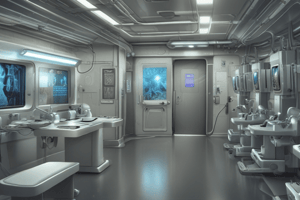Podcast
Questions and Answers
What role do noise reduction algorithms play in point cloud processing?
What role do noise reduction algorithms play in point cloud processing?
They filter out unwanted noise to improve the accuracy of the data.
Explain how registration algorithms contribute to the creation of a complete point cloud.
Explain how registration algorithms contribute to the creation of a complete point cloud.
They align and merge multiple scans to form a seamless representation of the object's geometry.
What is the purpose of down-sampling in point cloud data processing?
What is the purpose of down-sampling in point cloud data processing?
To reduce the number of points while retaining the overall shape and features of the data.
Describe the significance of normal estimation in point cloud processing.
Describe the significance of normal estimation in point cloud processing.
What are the differences between FPFH and SIFT in feature extraction?
What are the differences between FPFH and SIFT in feature extraction?
How does segmentation enhance point cloud processing?
How does segmentation enhance point cloud processing?
Why are algorithms like Iterative Closest Point (ICP) important for point cloud registration?
Why are algorithms like Iterative Closest Point (ICP) important for point cloud registration?
In which applications is feature extraction in point clouds particularly useful?
In which applications is feature extraction in point clouds particularly useful?
What are common techniques used for noise reduction in point clouds?
What are common techniques used for noise reduction in point clouds?
What are the implications of using high-resolution point cloud data?
What are the implications of using high-resolution point cloud data?
Study Notes
Non-Contact Measurement Devices
- Non-contact devices collect point data without physical interaction, enabling rapid data acquisition.
- Laser scanners are the most widely used non-contact measurement tools, notable for speed and accuracy in data collection.
- There has been significant improvement in the accuracy of laser scanning equipment, resulting in increased industrial use.
Compressed Tomography (CT) Scanners
- CT scanners analyze material composition and internal geometry of components, crucial in both medical and industrial applications.
- Medical CT imaging allows visualization of the human body, critical for surgical implant design.
- High-power industrial CT scanners can safely obtain data regarding the internal shape, porosity, and density of industrial items.
Reverse Engineering in Medicine
- Unique to the medical field, reverse engineering creates precise 3D models from CT or MRI scans, typically in DICOM format.
- Applications include surgical planning, implant design, and educational demonstrations.
- Initial steps involve processing CT or MRI scans to extract anatomical details, which are segmented based on pixel values.
Segmentation Process
- Scans are segmented according to x-ray attenuation coefficients, isolating the areas of interest for further processing.
- A mask is generated to represent the selected anatomy, leading to the creation of point cloud data.
Voxel Model Creation
- Voxel models depict 3D objects by dividing them into a three-dimensional grid of voxels, aiding in visualizing scanned anatomy.
- Point cloud data is transformed into STL (Stereolithography) files, which are essential for 3D printing, focusing on object surface geometry.
3D Printing and Application
- STL files facilitate the 3D printing of medical models, assisting in surgical preparations, implant designs, and patient education.
- The reverse engineering process requires specialized software and expertise to ensure accuracy and detail.
Point Cloud Processing Operations
- Noise Reduction: Algorithms like statistical outlier removal and moving least squares filter unwanted noise from scanned data.
- Registration: Multiple scans are aligned and merged using algorithms such as Iterative Closest Point (ICP) for complete geometry representation.
- Down-Sampling: High-resolution point clouds are reduced using voxel grid filtering and random sampling to ease computational demands.
- Normal Estimation: Algorithms like PCA compute surface normals, critical for mesh generation and reconstruction tasks.
- Feature Extraction: Algorithms like FPFH and SIFT identify edges, corners, and planes in point clouds for object recognition and segmentation.
- Segmentation: Segregation of various objects in point clouds is essential for focused processing and analysis.
Studying That Suits You
Use AI to generate personalized quizzes and flashcards to suit your learning preferences.
Related Documents
Description
Explore the world of non-contact measurement devices, focusing on laser scanners and their capabilities. Understand how these technologies gather point data efficiently without physical contact. This quiz covers the advancements in accuracy and industry applications of laser scanning equipment.




